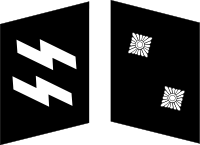- Oberscharführer
-
The title of this article contains the character ü. Where it is unavailable or not desired, the name may be represented as Oberscharfuehrer.
Oberscharführer was a Nazi Party paramilitary rank that existed between the years of 1932 and 1945. Translated as “Senior Squad Leader”, Oberscharführer was first used as a rank of the Sturmabteilung (SA) and was created due to an expansion of the enlisted positions required by growing SA membership in the late 1920s and early 1930s. The SA rank of Oberscharführer was senior to Scharführer and junior to the rank of Truppführer.
Since early ranks of the Schutzstaffel (SS) were identical to the ranks of SA, Oberscharführer was created as an SS rank at the same time the position was created within the SA. Initially, the rank of SS-Oberscharführer was equal to its SA counterpart; however, this changed in 1934 following the Night of the Long Knives.
At that time, the SS rank system was reorganized and several new ranks established with older SA titles discontinued. The rank of SS-Oberscharführer was therefore “bumped up” and became equal to an SA-Truppführer. The insignia for the SS rank was changed, as well, becoming two silver collar pips in contrast to the SA insignia for Oberscharführer which was a single collar pip with silver stripe.
Within the SA, an Oberscharführer was typically a squad leader, answering to a platoon non-commissioned officer. The responsibilities varied across a wider range in the SS, in particular between an Oberscharführer in the Allgemeine-SS (General SS) and one holding the same position in the Waffen-SS (Armed SS).
After 1938, when the SS adopted field grey uniforms as the standard duty attire, SS-Oberscharführers displayed the shoulder insignia of a Wehrmacht Feldwebel. The rank of SS-Oberscharführer was junior to SS-Hauptscharführer.
Junior Rank
ScharführerSS rank
OberscharführerSenior Rank
HauptscharführerJunior Rank
ScharführerSA rank
OberscharführerSenior Rank
TruppführerCategories:- SS ranks
Wikimedia Foundation. 2010.

